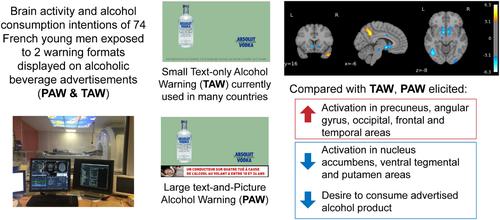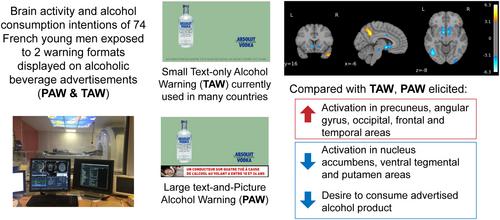Although the World Health Organization recommends visible and clear warning labels about the risks of alcohol consumption on containers and advertising, many of the currently used labels are too small to be visible. This study investigated the brain activity (using fMRI) and alcohol consumption intentions of French young men exposed to two warning formats displayed on alcoholic beverage advertisements: a small Text-only Alcohol Warning (TAW) currently used in many countries, and a larger text-and-picture alcohol warning (PAW).
Seventy-four eligible 18–25-year-old male drinkers completed a face-to-face individual visit with a physician expert in addiction medicine. This was followed by the fMRI session during which they viewed 288 stimuli [96 alcohol advertisements with TAWs, the same 96 advertisements with PAWs, and 96 water advertisements (controls)] for 3 s each. If the advertisement made participants want (“yes”)/do not want (“no”) to consume the product, they pressed the corresponding button (self-report responses). The number of “yes” responses was compared between advertisement types with a paired sample t-test. Whole-brain and region-of-interest (ROI) analyses of the fMRI data were performed.
Whole-brain BOLD fMRI highlighted contrasting effects of PAWs and TAWs. Compared with TAWs, PAWs elicited more activation in the precuneus, angular gyrus, occipital, frontal and temporal areas, and less activation in the nucleus accumbens, ventral tegmental areas, and putamen areas (regions of the reward circuit). The ROI analysis confirmed less activation in the reward circuit (left and right ventral tegmental areas, left and right nucleus accumbens) when viewing PAWs than TAWs. Analysis of the self-report responses indicated that the desire to consume the advertised alcohol product was lower when PAWs were viewed (compared with TAWs) (T = 8.18, p < 10−11).
This is the first fMRI study to assess the effect of different alcohol warning formats. Our findings show that compared with TAWs, stronger PAWs in advertisements elicited less activity in key regions of the reward system. This suggests that the effects may influence the desire to consume alcohol products (self-report response analysis). These results could help policymakers who are interested in developing more effective labeling measures that target young people.



